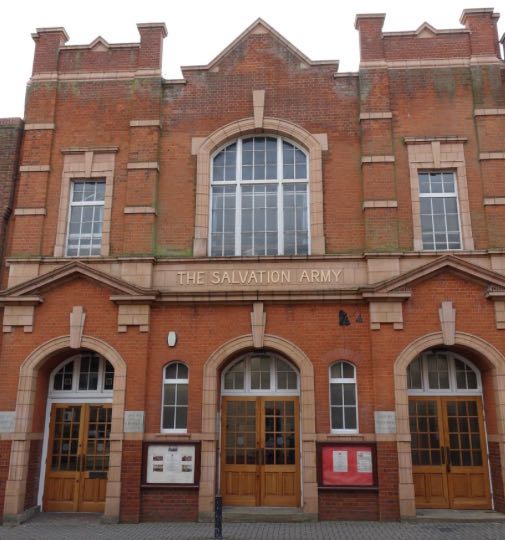Much outline detail is available concerning the presence of troops in training both in and around St Albans during the First World War. Photographs of soldiers marching along Hatfield Road, and encampments which were set up at Cunningham, Beech Road, Verulam Road, north of Sandpit Lane and at Oaklands. However, specific details of daily routines are sparse.
A friend has just passed to me a copy of an article written in 1914 and published in a newspaper called the Woman's Dreadnought. It was published by London East End groups led by Sylvia Pankhurst, and in this article the article's author came to the east end of St Albans where battalions of troops from Bow, Poplar and Stepney were billeted. So, already we know these weren't just "men"; they were groups from the same home areas and many were probably friends, or even siblings. The article gave accounts of the men's living conditions two inform their families back home in the East End and wider London.
 |
| The County hall north of St Peter's Street and close to Drovers Way was one billet for soldiers in training. |
We are informed of the kinds of accommodation being used: the County Hall (behind St Peter's Street), the Town Hall, Salvation Army accommodation (possibly the Citadel itself), schools (Camp, Fleetville and Hatfield Road), garages, stables, and empty and private houses. There were many large villas some of which would have been vacant, although a very small number may have been accommodated in even modest terraced dwellings. The Fleetville Institute contained a considerable number, and Oaklands Mansion had been handed over by the occupiers, Mrs and the Misses Fish, having the additional benefit of being the location of a tented training camp. Hatfield too was busy with troops.
 |
| This frequently seen postcard photograph shows a company of troops approaching the recreation ground en-route to Oaklands training camp or Hatfield. |
 |
| School premises were used in the early days of training. A number of soldiers, both on and off duty were being photographed outside Camp School. COURTESY ST ALBANS MUSEUMS |
Rations were a restricted range and quantity. "For breakfast we get two 1-lb pots of jam, two loaves, a pound of cheese and boiled bacon between eight men, with half a pint of tea each. The bread and jam is supposed to last for tea time, but it seldom does. At dinner time we sometimes get roast mutton and sometimes shackles (stew minus the carrots and onions), and potatoes served up in their skins. Anything else in the way of chicken, lamb, butter, milk and eggs we buy (when we ain't broke)."
Remembering these are soldiers in training the days are long and were intended to prepare the men for arduous activity on the battlefield. "We rise at 5.30, breakfast at 6 and parade at Hatfield Park at 7.30." So that means reaching there on foot from their billets. "Some days the whole battalion goes out for a field day; other times our own companies for drill. We generally go out for five or six miles out of the town and arrive home about one o'clock."
More parading and marching takes up the afternoon with the day finishing at about 8 in the evening. As an example of something different one day was described as digging trenches and standing in them all night until the following morning, when a practice battle took place. A 25 mile march was referred to and presumably this was also a regular feature of training.
 |
| Wet conditions at the lower end of Cunningham Field adjoining London Road. |
For the benefit of the wives and families at home mention was made of the YMCA who had erected a large tent for the benefit of the men during their down time. No mention of its location was made in the article.
"Paper, ink and pens are provided free of charge, as also are games and books. There is a platform and piano and concerts are frequently given. A lady gives lessons to men desiring to learn French, also free of charge. A canteen is next door where the men can get food and drinks." It was not stated whether these were also provided free.
The report makes it clear the majority of the men were fed up with the period they have spent in St Albans and were anxious to make progress to "abroad". But while here they have received formal visits from the Mayor of Poplar and the Town Clerk. Lord Kitchener also arrived to review the battalion.
Simply recording that certain battalions and companies were in training at given locations tells a poor story on its own. To be in a position to relate what the men were doing for their training, what they thought about their day to day circumstances and how they occupied themselves in their limited spare time, adds much fullness to what we can record of their period in St Albans. And how appropriate to know where the homes of the men were. In 1913 Councillor and the manager of Smith's Printing Works, Ernest Townson, compared the circumstances of Fleetville's untidiness to London's East End. Now, this district was hosting thousands of soldiers whose homes were in Bow, Stepney and Poplar, very much part of London's East End.




No comments:
Post a Comment